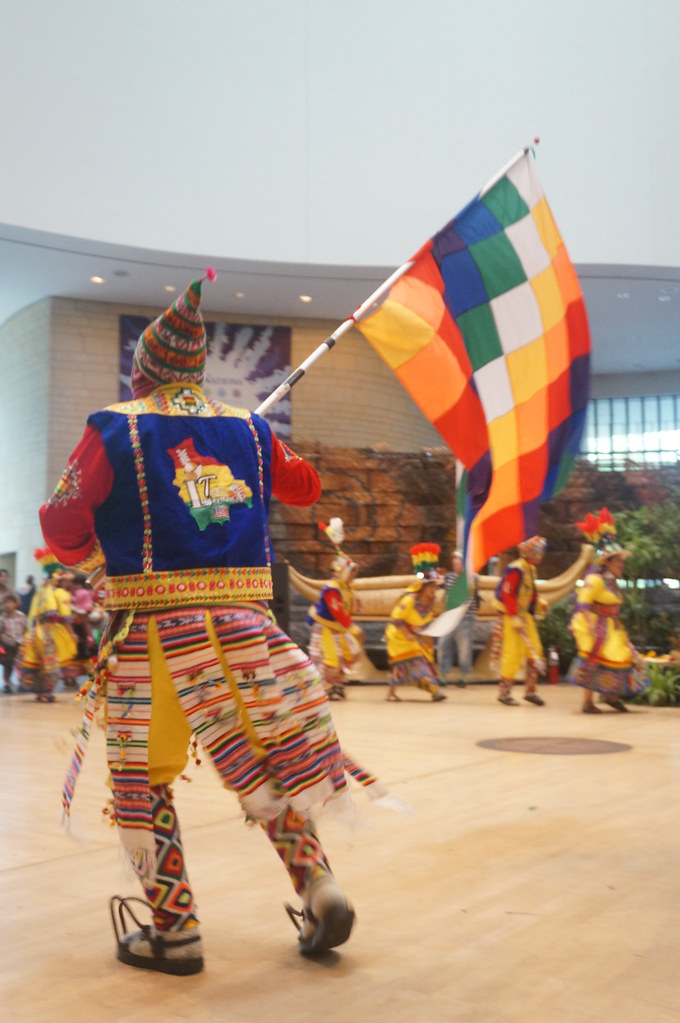While working in Ecuador, one of my most memorable trips with coworkers was to visit Cotacachi and Cuicocha, a couple hours north of Quito in the province of Ibarra. The area is beautiful, and our trip was made especially memorable because we happened to arrive in the town during Inti Raymi - the Inca festival of the sun.
 |
| Lago Cuicocha, Ibarra, Ecuador, 2013 |
Inti Raymi is a celebration of the winter solstice throughout many Andean communities across Bolivia, Peru, and Ecuador (remember, it's the Southern Hemisphere so their winter solstice is the northern's summer solstice). Taking place on the shortest day of the year, the festival is a celebration of the sun, longer days, planting, and the harvest to follow. Although the festival itself is widely celebrated, each community has its own unique expression.
 |
| Inti Raymi Dancers, Cotacachi, Ecuador, 2013 |
On the day that we arrived, the festival was celebrated with groups of men in sheepskin chaps, tall hats, and metal whips whistling and dancing in circles, weaving their way through the town (with riot police on standby in case any dancer became overzealous). The trip was a lot of fun, even with the gambles that come from eating street food and hitch hiking nighttime buses back to Quito.
In Washington, D.C., the Smithsonian's National Museum of the American Indian hosted its own version of Inti Raymi this year. You can see Smithsonian's pictures from the event here. The festivities began with an opening ritual for the fertility of Pachamama (mother earth) in the tradition of the town of Macha, in the northern Bolivian province of Potosí. The festival incorporates both pre-Columbian and Christian elements.
 |
| Tinku Pachamama Ritual |
Then the dances began! It's hard to capture here how amazing these dancers were. They performed three performances with only a half hour break between each, but never lost any energy. The beat pulsed through the museum with each unfaltering step.
 |
| Bolivian Dancer |
The first set of dances were the zapateados, dances that showcase the performers' footwork and focus on rhythm. The next set of dances were the Huaylas, a dance from the highlands in which the dancers imitate the movements they perform in the fields while sowing potatoes.
 |
| Huaylas Highland Dance |
My favorite dance was the Tinku, variations of which are performed in parades. This dance was the most energetic, with the dancers spinning and jumping, keeping pace with a quick rhythm. The skill of the individual dancers, and the dancers as a whole, unparalleled with this dance.
 |
| Tinku Troupe Dance |
The audience even got involved too!
The dancing, music, and colors were beautiful. The festival as celebrated in D.C. had more Bolivian and Peruvian influences, but it was really cool to see how a festival with similar roots was celebrated by these communities in the United States as compared to the festival I observed in a small Ecuadorian town.
I thanked one of the Bolivian dancers after the show for sharing her performance, and her emotional reply left an impression with me: "I have lived in this country for 28 years and have never felt more Bolivian than I do today. To perform in the Inti Raymi festival, in the nation's capital, here in this museum is a tremendous honor for me."
 |
| Dancer with Andean Indigenous Movement flag |



 6:42 PM
6:42 PM
 J-Mad
J-Mad






 Posted in:
Posted in: 
0 comments:
Post a Comment